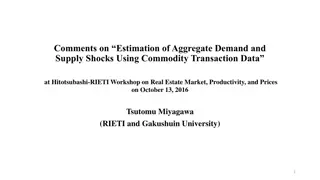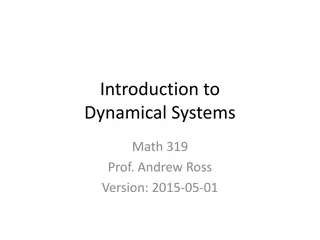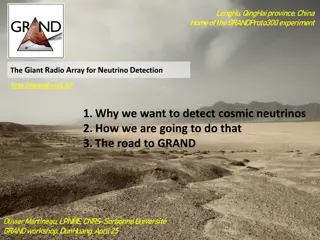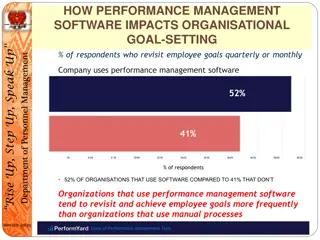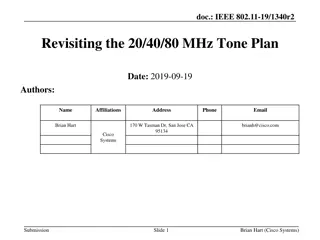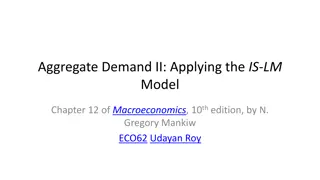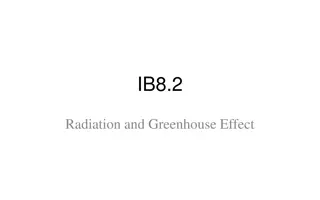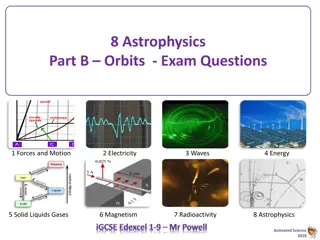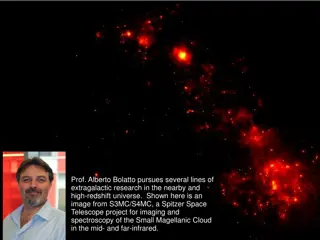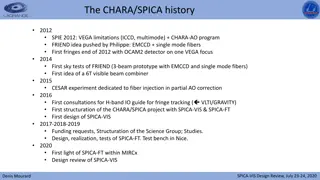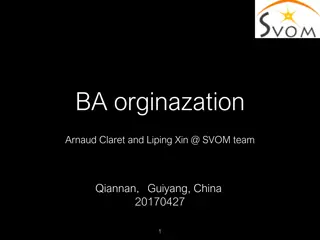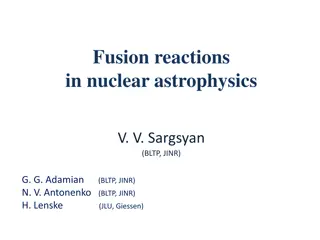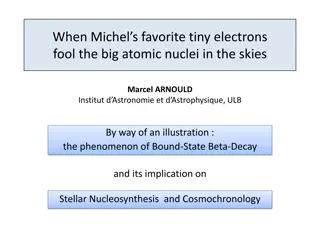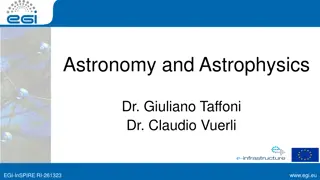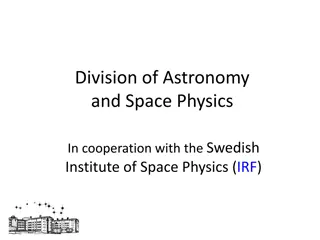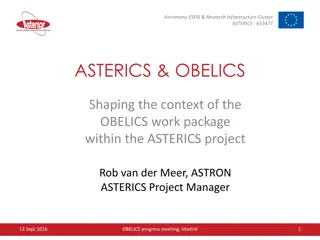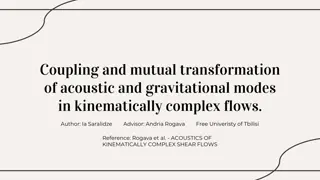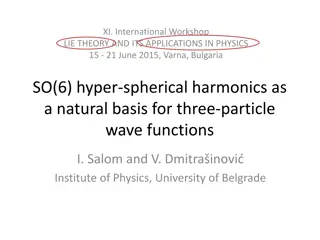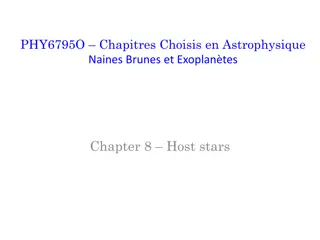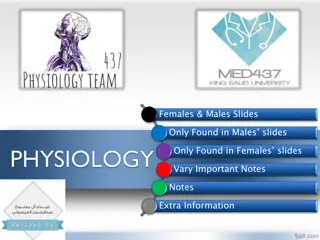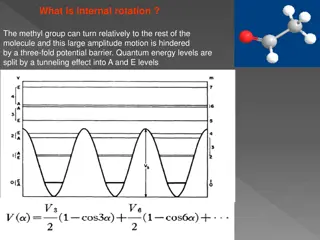Revisiting Dynamical Properties of Internal Shocks in Astrophysics
This study investigates the dynamical properties of internal shocks in astrophysical phenomena such as gamma-ray bursts. It delves into the rapid variability in X-ray light curves and explores the mechanisms behind colliding plasma shells, providing insights into shock wave interactions and thermodynamic properties.
Download Presentation

Please find below an Image/Link to download the presentation.
The content on the website is provided AS IS for your information and personal use only. It may not be sold, licensed, or shared on other websites without obtaining consent from the author. Download presentation by click this link. If you encounter any issues during the download, it is possible that the publisher has removed the file from their server.
E N D
Presentation Transcript
Dynamical properties of internal shocks revisited Asaf Pe er, Killian Long, Piergiorgio Casella (UCC) (UCC) (INAF-Roma) Astrophys. Journal, submitted arXiv:1610.08712
Motivation How to explain - Rapid variability in X-ray lightcurve in GRBs X-ray lightcurve of the XRB GX 339-4 (BATSE, Swift, Fermi ) (Casella+2010)
A leading idea: internal shocks Rees & Meszaros 1994; Sari & Piran 1995, 1997; Kobayashi+1997; Daigne & Mochkovich 1998; Meszaros 2000; .. Figure from Meszaros & Rees 2014 Variability in the inner engine ejection of separated plasma shells; Fast shell catches slower shell ejected previously Shock waves
A leading idea: internal shocks Following the first collision, the shells are no longer cold !! Shell 1 (slow) Shell 2 (fast) 2 > 1 Contact discontinuity Reverse shock Forward shock At time t Shells collide Shell 2 (fast) shocked Shell 2 shocked Shell 1 Shell 1 (slow)
Thermodynamic properties Reverse shock Contact discontinuity Forward shock 4 3 2 1 Shell 2 (fast) Shell 1 (slow) shocked Shell 2 shocked Shell 1 e2 n2 Unknowns: energy density e4 number density n4 pressure Velocity 4 rs p3 3 e3 n3 p2 fs p1 e1 n1 p4 2 1 Total 18 unknowns Knowns: Shock jump conditions (x2): conservation particle, energy & momentum flux densities : 6 Contact discontinuity: p2 = p3 ; 2 = 3 Equations of state: pi = ( i-1)(ei-ni), i=1..4 ( i = adiabatic index) Total 12 Equations Need 6 boundary conditions ( 1, n1, e1, 4, e4, n4 )
Results (I): colliding shells velocities Collision between cold plasmas: e1 = e4 = 0; n4/n1 = 100; 1 = 1 3: L.F. of shocked plasma (3) as seen from region (4) Relativistic limit ( 4 >>1): 1/4 G4 2 w4 w1 G2= G3@ i = ei + pi = enthalpy Non. Rel. limit ( 4 <<1), cold: n4 n1 b2@ b4 n4 n1 1+ Simple analytical expressions; L.F. depends on ratio of enthalpies
Results (II): minimum velocity for shock formation Collision between hot plasmas: e1/n1 = 15, e4/n4 = 10; n4/n1 = 1; 1 = 1 3: L.F. of shocked plasma (3) as seen from region (4) Relativistic limit ( 4 >>1): w4 w1 w1 w4 G4 3 8max , i = ei + pi = enthalpy Lower limit on L.F. depends on ratio of enthalpies Physical origin: impossibility of dissipating thermal energy from hot plasma
Results (III): energy density, energy per particle Collision between hot plasmas: e1/n1 = 15, e4/n4 = 10; n4/n1 = 1; 1 = 1 1. Relativistic limit ( 4>>1): G4 2 w1 3/4w4 n1 1/4 e2=e3=2G4w1w4 e2 n2 = Simple analytical expressions in relativistic limit
Results (IV): energy density, energy per particle Collision between cold plasmas: e1/n1 = 1.0001, e4/n4 = 1.002; n4/n1 = 1/20 2. Non-relativistic limit ( 4<<1): Discriminate between: Hot: (e1-n1)/n1 >> 1 Cool: 22 << (e1-n1)/n1 << 1 Cold: (e1-n1)/n1 << 22 Simple analytical expressions in all limits.
Observational consequences: synchrotron Reverse shock Contact discontinuity Forward shock 4 3 2 1 Shell 2 (fast) Shell 1 (slow) shocked Shell 2 shocked Shell 1 Width = 4 Width = 1 2 nsyn,2 nsyn,3 B2gel,2 B3gel,3 2 2 B N t 2 w1 w4 =n4 Synch. Emission provides direct information about ratios of width, density, enthalpies 2 n1 P 2 el N B n 2 = 2 , syn 2 , 1 4 1 2 2 el P n 3 3 , 3 3 , 4 1 4 syn = fs 1 1 t (rel.) 4 4 rs
Summary Internal shocks are (still) a leading model for explaining the rapid variability seen in GRBs, XRBs, AGN flares. Following the first collision, the shells are not cold. We solved the general problem of arb. hot shells colliding at arb. speeds. We found simple analytical expressions in the relativistic and Newtonian cases, for hot , cool and cold regimes. Observations of synchrotron emission can probe the properties of the shells properties of the inner engine Ap. J., submitted arXiv:1610.08712
Adiabatic index Numerical calculation Exact numerical calculation at all regimes (Service, 1986)


